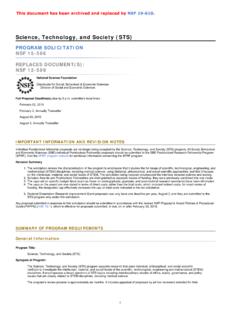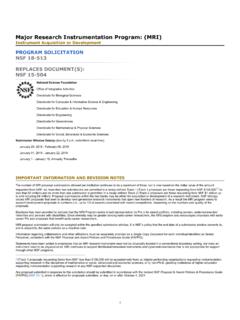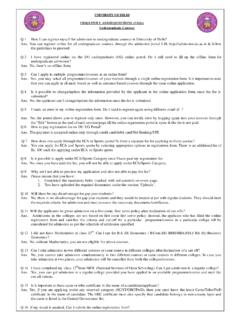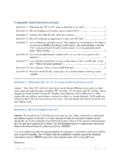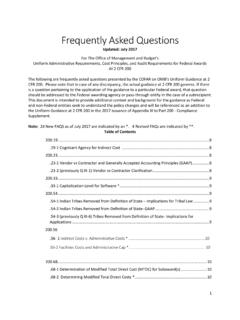Transcription of Frequently Asked Questions (FAQs)
1 Frequently Asked Questions ( faqs ) On Proposal Preparation and Award Administration Effective January 2017 A Administrative Corrections What should I do if I notice an error in a proposal I just submitted via FastLane? It is the responsibility of the proposing organization to thoroughly review each proposal prior to submission. On occasion, however, a problem is identified with a portion of the proposal after the proposal has been submitted electronically to NSF. The FastLane Proposal File Update Module allows the organization to request the replacement of files or revision of other Proposal Attributes, associated with a previously submitted proposal.
2 A request for a proposal file update must be submitted by an Authorized Organizational Representative (AOR). The Proposal File Update module, however, may not be used for submission of revised budgets. All budgetary revisions must be submitted through use of the FastLane Revised Proposal Budget Module. More information on and submission procedures for proposal file updates can be found in the Proposal & Award Policies & Procedures Guide (PAPPG) Chapter Audit Reports Where should copies of audits required by 2 CFR 200, Subpart F be sent? In accordance with 2 CFR Part 200, Uniform Administrative Requirements, Cost Principles, and Audit Requirements for Federal Awards (Uniform Guidance), grantees that are states, local governments or non-profit organizations must submit copies of their audit reports to the Federal Audit Clearinghouse (FAC).
3 See 2 CFR (b) for additional information. Award Administration Where can I find information regarding post-award issues? Information regarding pre-award costs, required notifications and prior approvals, extensions, transfer of the award, reporting requirements and other award administration requirements can be found by accessing the applicable award conditions on the NSF website. Additional information regarding the award and administration of NSF grants and cooperative agreements may be found in Part II of the Proposal & Award Policies & Procedures Guide (PAPPG).
4 2 B Biographical Sketches Instructions for the Biographical Sketch(es), Products section indicate that acceptable products must be citable and accessible. Accessibility may be difficult to accomplish in the case of manuscripts submitted or accepted for publication and other documents and materials. Access may need to be provided through organizational or personal websites. Will that be sufficient to meet the proposal submission requirements? The language was changed from publications to products in order to allow proposers to receive appropriate credit for research products that may not be traditional publications.
5 The requirement that all products be "citable and accessible" is not a submission requirement, in the sense of blocking a proposal from consideration, but a definition of the standard to which proposers should adhere. It was introduced because of experience with citations that are not readily available, including web references that are inaccessible or out of date, and is intended to indicate that such mistakes have demonstrably downgraded a proposal in the judgment of reviewers. References to websites, even private ones, are appropriate, provided that the site is available for a reasonable percentage of the time.
6 Such material is often the best way to demonstrate the applicant's ability to carry out the project. For Biographical Sketch(es), now that Publications has become Products, are proposers still limited to the same number of Products as they were Publications? Yes. The proposer may include up to five products most closely related to the proposed project and up to five other significant products, whether or not related to the proposed project. C Categories of Funding Opportunities What types of mechanisms does NSF use to generate proposals? In what scenario is each mechanism used?
7 NSF utilizes a variety of mechanisms to generate proposals. There are four categories of funding opportunities: Dear Colleague Letters, Program Descriptions, Program Announcements and Program Solicitations. For a description of each category and further information, see PAPPG Chapter CFDA Numbers What is the CFDA number and where can a proposer find it? The Catalog of Federal Domestic Assistance (CFDA) profiles all Federal grant programs and is jointly issued by the Office of Management and Budget (OMB) and the General Services Administration (GSA).
8 The Catalog is available for reference in the Government documents section of most major libraries and in the offices of state and local 3 governments. The CFDA number is important for tracking and audit purposes. The applicable CFDA number is identified in the Summary section of NSF program announcements and solicitations. A complete listing of NSF CFDA numbers, by Division, is included on the DIAS/Policy Office website. Collaborative Proposals What is a collaborative proposal? A collaborative proposal is one in which investigators from two or more organizations wish to collaborate on a unified research project.
9 Collaborative proposals may be submitted to NSF in one of two methods: as a single proposal, in which a single award is being requested (with subawards administered by the lead organization); or by simultaneous submission of proposals from different organizations, with each organization requesting a separate award. All components of the collaborative proposal must meet any established deadline, and, failure to do so may result in the entire collaborative proposal being returned without review. PAPPG Chapter contains additional information and instructions regarding collaborative proposals.
10 Concurrent Proposals Can a proposer submit the same proposal to different organizations within NSF for simultaneous review? Only one submission should be provided to NSF even if review by multiple programs is envisioned. Proposers may indicate on the Cover Sheet which NSF organizational unit(s) they believe would be most appropriate for proposal review. However, NSF will determine which program will evaluate each proposal. The submission of duplicate or substantially similar proposals concurrently for review by more than one program without prior NSF approval may result in the return of the redundant proposal(s).

